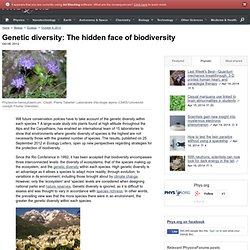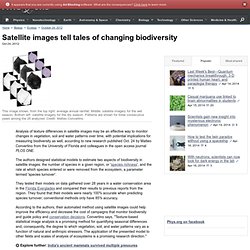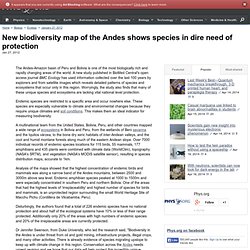

Bases neuropédagogiques de l'apprentissage. Dinosaure.
50 000 observations pour la forêt. Genetic diversity: The hidden face of biodiversity. Will future conservation policies have to take account of the genetic diversity within each species ?

A large-scale study into plants found at high altitude throughout the Alps and the Carpathians, has enabled an international team of 15 laboratories to show that environments where genetic diversity of species is the highest are not necessarily those with the greatest number of species. Satellite images tell tales of changing biodiversity. Analysis of texture differences in satellite images may be an effective way to monitor changes in vegetation, soil and water patterns over time, with potential implications for measuring biodiversity as well, according to new research published Oct. 24 by Matteo Convertino from the University of Florida and colleagues in the open access journal PLOS ONE.

The authors designed statistical models to estimate two aspects of biodiversity in satellite images: the number of species in a given region, or 'species richness', and the rate at which species entered or were removed from the ecosystem, a parameter termed 'species turnover'. They tested their models on data gathered over 28 years in a water conservation area in the Florida Everglades and compared their results to previous reports from the region. They found that their models were nearly 100% accurate when predicting species turnover; conventional methods only have 85% accuracy.
New biodiversity map of the Andes shows species in dire need of protection. The Andes-Amazon basin of Peru and Bolivia is one of the most biologically rich and rapidly changing areas of the world.

A new study published in BioMed Central's open access journal BMC Ecology has used information collected over the last 100 years by explorers and from satellite images which reveals detailed patterns of species and ecosystems that occur only in this region. Worryingly, the study also finds that many of these unique species and ecosystems are lacking vital national level protection. Endemic species are restricted to a specific area and occur nowhere else.
These species are especially vulnerable to climate and environmental changes because they require unique climates and soil conditions. New film about juncos offers fresh insights into common birds - BirdWatching. In a scene from “Ordinary Extraordinary Junco,” a banded Dark-eyed Junco approaches its nest, which contains three eggs.

I see Dark-eyed Juncos every winter in my Milwaukee backyard, and they never fail to chase away the dreariness and cold. After a moment or two, however, I usually turn my attention to something else. I’ve seen lots of juncos, after all. But later this year, when the small gray birds return, I will look at them with a different eye. A new documentary has given me a fresh understanding of the birds’ behaviors and evolutionary history and an appreciation for the scientists who have been working for decades to uncover their secrets. What We Can Learn From The Largest International Study On Rape That's Been Conducted So Far. By Tara Culp-Ressler "What We Can Learn From The Largest International Study On Rape That’s Been Conducted So Far" The UN study surveyed over 10,000 men from Bangladesh, China, Cambodia, Indonesia, Papua New Guinea, and Sri Lanka.

The researchers caution that some regional attitudes about sexuality in Southeastern Asia may contribute to the results that they gathered across those six countries. Still, though, there are some big takeaways from their findings. 50 Astounding Facts About Rainforests (INFOGRAPHIC) Rainforests play a critical role in the maintenance of our planet's good health.

Not only are they home to more than half of the world's species of flora and fauna, rainforests are also the source of about 40 percent of the planet's oxygen supply. They also help to maintain the Earth's fresh water levels, as well as regulate temperatures and weather patterns. Sadly, despite being so rich, diverse and life-giving, humans continue to wreck these priceless habitats through deforestation. 10 Freaky Animals You Have to See to Believe. Exténuante descendance : pour l’espérance de vie d’une abeille, mieux vaut ne pas naitre en été. Si vous aviez à renaitre en tant qu’abeille ouvrière, assurez-vous de ne pas le faire en été.

C’est le moment de l’année où la reine exige le plus de gelée pour nourrir ses petites, et une fois que le travail est fait, les abeilles meurent généralement deux semaines plus tard. Mais en hiver, des abeilles similaires peuvent vivre six à sept mois, ce qui est cinq fois plus longtemps que leurs homologues d’été. Élever des jeunes est vraiment stressant, apparemment. Le chercheur Daniel Münch, de l’Université norvégienne des Sciences de la Vie, a récemment enquêté sur cette énorme différence dans l’espérance de vie des abeilles.
Il a constaté que les abeilles d’hiver ne montraient aucun signe de déclin mental en vieillissant, en effet, même après six mois de vie, leurs capacités cognitives étaient équivalentes à celles d’une abeille de 9 jours (dans la fleur de l’âge). Et Münch raconte : Stunning Map Reveals World's Earthquakes Since 1898 ǀ Plate Tectonics Map. If you've ever wondered where — and why — earthquakes happen the most, look no further than a new map, which plots more than a century's worth of nearly every recorded earthquake strong enough to at least rattle the bookshelves.

The map shows earthquakes of magnitude 4.0 or greater since 1898; each is marked in a lightning-bug hue that glows brighter with increasing magnitude. The overall effect is both beautiful and arresting, revealing the silhouettes of Earth's tectonic boundaries in stark, luminous swarms of color. The map's maker, John Nelson, the user experience and mapping manager for IDV Solutions, a data visualization company, said the project offered several surprises. What Does Ocean Acidification Mean for Sea Life?